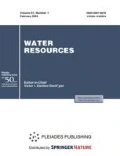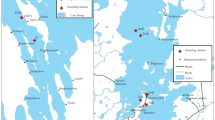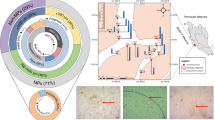Abstract
The concentration of microplastic particles (with size from 100 µm to 5 mm) and their chemistry were studied in water, subsoils and sediments in the coastal area of the Neva Bay, the Gulf of Finland. The characteristics determined in the study were the dominating shapes of the particles, their size range, polymer chemistry and concentrations in different media, i.e., in water, bottom sediments, and coastal subsoils. Microplastic concentrations in bottom sediments and coastal subsoils are far in excess of their concentration in water mass. The spatial distribution of microplastic particles was studied in water, coastal subsoils, and bottom sediments of the Neva Bay, the Gulf of Finland. Microplastic concentration at the water edge was found to decrease with the distance from St. Petersburg City and Neva mouth, along either the northern or the southern coast. After reaching the Gulf of Finland, the Neva water, polluted by microplastic particles, is diluted and continues moving and distributing in accordance with the dominating westward hydrodynamic transport.









Similar content being viewed by others
REFERENCES
Eremina, T.R. and Ershova, A.A., Studying the problem of marine rubbish in the region of the Gulf of Finland, Tr. II Vseros. Konf. “Gidrometeorologiya i ekologiya: dostizheniya i perspektivy razvitiya” (Proc. II All-Russia Conf. Hydrometeorology and Ecology: Results and Development Perspectives), 2018, pp. 254–246.
Kondrashkova, I.S., Martinson, K.D., Zakharova, N.V., and Popkov, V.I., Synthesis of nanocrystalline HoFeO3 photocatalyst via heat treatment of products of glycine-nitrate combustion, Russ. J. Gen. Chem., 2018, vol. 88, no. 12, pp. 2465–2471.
Martinson, K.D., Cherepkova, I.A., and Sokolov, V.V., Formation of cobalt ferrite nanoparticles via glycine-nitrate combustion and their magnetic properties, Glass Phys. Chem., 2018, vol. 44, no. 1, pp. 21–25.
Andrady, A.L., Microplasticss in the marine environment, Mar. Pollut. Bull., 2011, vol. 62, pp. 1596–1605.
Araujo, C.F., Nolasco, M.M., Ribeiro, A.M.P., and Ribeiro-Claro, P.J.A., Identification of microplastics using Raman spectroscopy: latest developments and future prospects, Water Res., 2018, vol. 142, pp. 426–440.
Barnes, D.K.A., Galgani, F., Thompson, R.C., and Barlaz, M., Accumulation and fragmentation of plastic debris in global environments, Philos. Trans. R. Soc., vol. 364, no. 1526, pp. 1985–1998.
Besley, A., Vijver, M.G., Behrens, P., and Bosker, T., A standardized method for sampling and extraction methods for quantifying microplastics in beach sand, Mar. Pollut. Bull., 2017, vol. 114, no. 1, pp. 77–83.
Cole, M., Lindeque, P., Halsband, C., and Galloway, S.C., microplastics as contaminants in the marine environment: a review, Mar. Pollut. Bull., 2010, vol. 62, pp. 2588–2597.
Crichton, E.M., Noel, M., Gies, E.A., and Ross, P.S., A novel, density-independent and FTIR-compatible approach for the rapid extraction of microplastics from aquatic sediments, Anal. Methods, 2017, no. 9, pp. 1419–1428.
Geyer, R., Jambeck, J.R., and Law, K.L., Production, use, and fate of all plastics ever made, Sci. Adv., 2017, vol. 3, no. 7, p. 5.
Gregory, M.R., Plastic 'scrubbers' in hand cleansers: a further (and minor) source for marine pollution identified, Mar. Pollut. Bull., 1996, vol. 32, pp. 867–871.
Hammer, J., Kraak, M.H., and Parsons, J.R., Plastics in the marine environment: the dark side of a modern gift, Rev. Environ. Contam. Toxicol., 2012, vol. 220, pp. 1–44.
Henry, B., Laitala, K., and Klepp, I.G., Microfibres from apparel and home textiles: prospects for including microplastics in environmental sustainability assessment, Sci. Total Environ., 2019, vol. 652, pp. 483–494.
Hidalgo-Ruz, V., Gutow, L., Thompson, R.C., and Thiel, M., microplastics in the marine environment: a review of the methods used for identification and quantification, Environ. Sci. Technol., 2012, vol. 46, no. 6, pp. 3060–3075.
Karlsson, T.M., Vethaak, A.D., Almroth, B.C., Freek, A., van Velzen, M., Hassellov, M., and Leslie, H.A., Screening for microplastics in sediment, water, marine invertebrates and fish: method development and microplastic accumulation, Mar. Pollut. Bull., 2017, vol. 122, pp. 403–408.
Masura, J., Baker, J., Foster, G., and Arthur, C., Laboratory methods for the analysis of microplastics in the marine environment: recommendations for quantifying synthetic particles in waters and sediments. NOAA technical memorandum NOS-OR&R-48, NOAA Marine Debris Program, 2015.
Mato, Y., Isobe, T., Takada, H., Kanehiro, H., Ohtake, C., and Kaminuma, T., Plastic resin pellets as a transport medium for toxic chemicals in the marine environment, Environ. Sci. Technol., 2001, vol. 35, pp. 318–324.
Pan, Z., Guo, H., Chen, H., Wang, S., Sun, X., Zou, Q., Zhang, Y., Lin, H., Cai, S., and Huang, J., microplastics in the Northwestern Pacific: Abundance, distribution, and characteristics, Sci. Total Environ., 2019, vol. 650, pp. 1913–1922.
Prata, J.C., Costa, J.P., Duarte, A.C., and Rocha-Santos, T., Methods for sampling and detection of microplastics in water and sediment: a critical review, TrACTrends Anal. Chem., 2019, vol. 110, pp. 150–159.
Umamaheswari, S. and Murali, M., FTIR spectroscopy study of fungal degradation of poly (ethylene terephthalate) and polystyrene foam, Chem. Eng., 2013, vol. 64, pp. 19159–19164.
Zhang, H., Transport of microplastics in coastal seas, Estuarine, Coastal Shelf Sci., 2017, vol. 199, pp. 74–86.
Zobkov, M. and Esiukova, E., Microplastics in Baltic bottom sediments: Quantification procedures and first results, Marine Pollution Bull., 2017, vol. 114, pp. 724–732.
Funding
This study was carried out under Governmental Order to the Institute of Limnology, Russian Academy of Sciences (subject no. 0154-2019-0003, Development of Integrated Methods for Studying and Evaluating the Characteristics of Solid Particles at Nanoscale Size in Water Bodies Subject to Different Anthropogenic Load).
Author information
Authors and Affiliations
Corresponding authors
Additional information
Translated by G. Krichevets
Rights and permissions
About this article
Cite this article
Pozdnyakov, S.R., Ivanova, E.V., Guzeva, A.V. et al. Studying the Concentration of Microplastic Particles in Water, Bottom Sediments and Subsoils in the Coastal Area of the Neva Bay, the Gulf of Finland. Water Resour 47, 599–607 (2020). https://doi.org/10.1134/S0097807820040132
Received:
Revised:
Accepted:
Published:
Issue Date:
DOI: https://doi.org/10.1134/S0097807820040132




